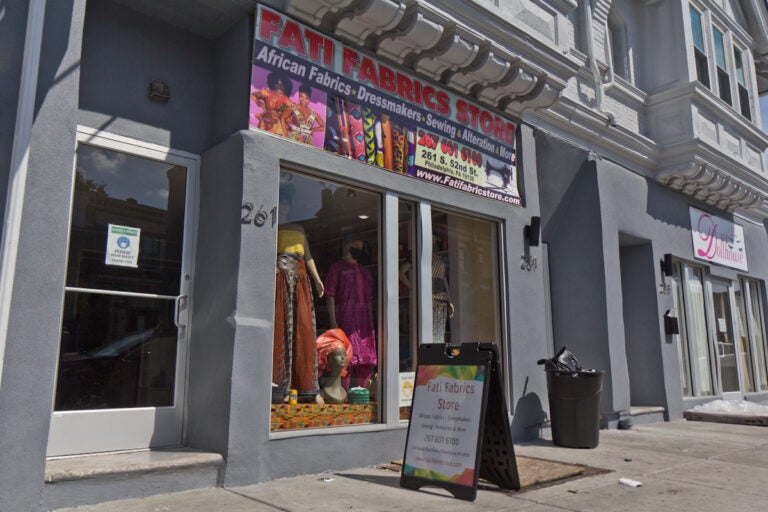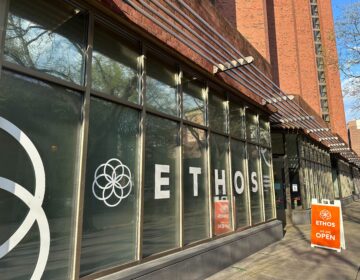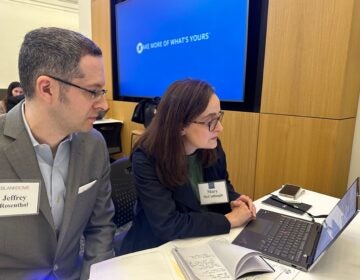Historic 52nd St. fighting for another comeback
The historic Black business district has seen plenty of ups and downs over the years. Can it come back again from a pandemic and widespread looting and vandalism?
Listen 16:37
Fati Fabric Store on 52nd Street. The owners moved to the area because of the foot traffic. (Kimberly Paynter/WHYY)
52nd Street, which has historically been the Black commercial hub of West Philly, has seen many ups and downs over the last few decades. It was most recently hit hard by the COVID-19 pandemic and then, by looting and vandalism during the unrest over racism.
Retired Philadelphia Daily News Columnist Elmer Smith reflects on growing up in the neighborhood and its rich history, and PlanPhilly reporter Darryl C. Murphy talks about the latest blows to 52nd Street, and what the future could hold.

Hear the whole story on The Why
Elmer Smith on the 52nd Street of his youth
Christmas was a time when the street was lit up from 52nd and Market all the way to Baltimore Avenue, essentially. It was kind of a festive Christmas that you would expect in almost any neighborhood, except that because it was a commercial, corridor, just to sort of like a critical mass. It was this little Broadway.
Elmer Smith on bringing his granddaughter to the neighborhood
I remember taking my oldest granddaughter on a ride through the neighborhood. We came up one of the street past West Philadelphia High School where my wife and I had gone to school and she looked at it. She said, “Looks like a prison.” And then we got to the second one and I pointed out the store where I first saw the clothes that I paid for. It was boarded. When we got to my mother’s house, she said, “This is like a terrible place to grow up.” And I was stunned. I saw the blight, but it retained its magic for me for some reason … I can’t fool myself … Now I see it struggling, hopeful that then it can come back because community that is served is still there. People still live here. There was a need for those businesses when I was growing up. There’s still in need.
Darryl C. Murphy on obstacles facing the corridor lately
You had a lot of a lot of white flight, a lot of disinvestment. Of course, you have the impacts of redlining and systemic racism and those things just kind of like deteriorating the neighborhood. So by the time we get to the 2000s, it’s just a dangerous place. It gained the reputation of being one of the deadliest corners in the city … And then to further complicate that, you had this SEPTA project where they wanted to revamp the [Market Frankford El]. And so they revamped the 52nd and Market stop, and that lasted a decade. And that just turned a lot of traffic away, businesses were shut down, etc. And that project wasn’t done until like 2009.
Darryl C. Murphy on 52nd Street’s possible comeback
52nd Street is still a point of interest for people. There’s a youth organizations called YEAH, which stands for Youth Empowerment for Advancement Hangout. They want to open a brick-and-mortar storefront so that they can have a place to continue to do their work for youth empowerment with young people in the area. And also Smith and Roller, which is a development company co-founded by Tayyib Smith. He wants to put an entrepreneurship hub near 52nd and Arch. And that’s another place where he wants to support young people and give them real skills … that will help them thrive in his 21st century economy. And so, there’s hope that businesses can continue to drive a renaissance for 52nd Street. That’s just not talked about a lot. The focus right now is helping businesses along the corridor get through this rough time and just try to maintain as much of the identity as much as they can.
WHYY is your source for fact-based, in-depth journalism and information. As a nonprofit organization, we rely on financial support from readers like you. Please give today.






